Related Research Articles

The Vishnu Sahasranama, is a Sanskrit hymn containing a list of the 1,000 names of Vishnu, one of the main deities in Hinduism and the Supreme God in Vaishnavism. It is one of the most sacred and popular stotras in Hinduism. The most popular version of the Vishnu Sahasranama is featured in the Anushasana Parva of the epic Mahabharata. Other versions exist in the Padma Purana, the Skanda Purana, and the Garuda Purana. There is also a Sikh version of the Vishnu Sahasranama found in the work Sundar Gutka.

Trimbakeshwar Shiva Temple is an ancient Hindu temple in the town of Trimbak, in the Trimbakeshwar tehsil in the Nashik District of Maharashtra, India, 28 km from the city of Nashik and 40 km from Nashik road. It is dedicated to the Hindu god Shiva and is one of the twelve jyotirlingas where the Hindu genealogy registers at Trimbakeshwar, Maharashtra are kept. The origin of the sacred Godavari River is near Trimbak.

Koodli, also spelled Kudli or Kudali, is a small historic village in Shimoga District, in the Indian state of Karnataka. It is at the sangam (confluence) of two rivers, the Tunga River and Bhadra River at nearly 1,200 metres (3,937 ft). They meet here to give rise to the Tungabhadra River, a tributary of the Krishna river. Their valleys host many architectural sites. The village was a much larger town and pilgrimage center before the 14th-century, one destroyed during the Islamic conquests of the south. Important temples and their ruins here include the Jagadguru Sri Shankaracharya Dakshinamnaya Sringeri Sharada Peetham, Sangamesvara temple, Ramesvara temple, Sri Chintamani Narasimha temple, Sringeri Vediki temple, Vishwakarma temple, Sharadamba temple, Amma Devasthana, Brahmeswara temple and the Shree Madhvacharya Kudli Arya Akshobhya Tirtha Matha. Other scattered ruins of unknown temples are also found here.

Raghavendra Tirtha, also referred as Raghavendra Swami, was a Vaishnava scholar, theologian, and saint. He was also known as Sudha Parimalacharya. His diverse oeuvre include commentaries on the works of Madhva, Jayatirtha, and Vyasatirtha, interpretation of the Principal Upanishads from the standpoint of Dvaita and a treatise on Purva Mimamsa. He served as the pontiff of the matha at Kumbakonam from 1621 to 1671. Raghavendra Tirtha was also an accomplished player of the veena and he composed several songs under the name of Venu Gopala. His memorial at Mantralayam attracts lakhs of visitors every year.
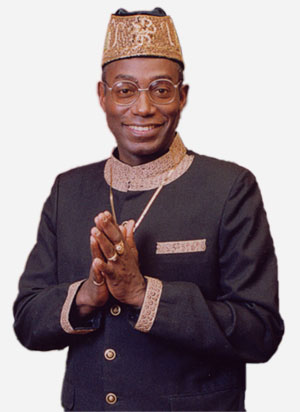
Bhakti Tirtha Swami, previously called John Favors and Toshombe Abdul and also known by the honorific Krishnapada, was a guru and governing body commissioner of the International Society for Krishna Consciousness. He was the highest-ranking African American in ISKCON.
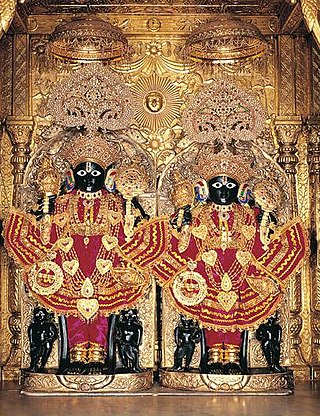
Naranarayana, also rendered Nara-Narayana, is a Hindu duo of sage-brothers. Generally regarded to be the partial-incarnation (aṃśa-avatara) of the preserver deity, Vishnu, on earth, Nara-Narayana are described to be the sons of Dharma and Ahimsa.
Tirtha is a Sanskrit word that means "crossing place, ford", and refers to any place, text or person that is holy. It particularly refers to pilgrimage sites and holy places in Hinduism, Buddhism and Jainism.
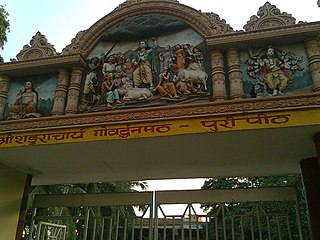
Purvamnaya Sri Govardhana Pitham or Govardhan Math is one amongst the four cardinal pithams established by the philosopher-saint Adi Shankara to preserve and propagate Hinduism and Advaita Vedanta, the doctrine of non-dualism. Located in Puri in Odisha, India, it is the Eastern Āmnāya Pītham amongst the four pithams, with the others being the Sringeri Śārada Pīṭhaṃ (Karnataka) in the South, Dvārakā Śāradā Pītham (Gujarat) in the West, Badari Jyotirmaṭha Pīṭhaṃ (Uttarakhand) in the North .It is associated with the Jagannath temple. Their Vedantic mantra or Mahavakya is Prajñānam brahma and as per the tradition initiated by Adi Shankara it holds authority over the Rigveda. The head of the matha is called Shankarayacharya, the title derives from Adi Shankara.

Swami Rama Tirtha, also known as Ram Soami, was an Indian teacher of the Hindu philosophy of Vedanta. He was among the first notable teachers of Hinduism to lecture in the United States, travelling there in 1902, preceded by Swami Vivekananda in 1893 and followed by Paramahansa Yogananda in 1920. During his American tours Swami Rama Tirtha spoke frequently on the concept of "practical Vedanta" and education of Indian youth. He proposed bringing young Indians to American universities and helped establish scholarships for Indian students.
Kankhal is a small colony in Haridwar in the Haridwar district of Uttarakhand state in India.
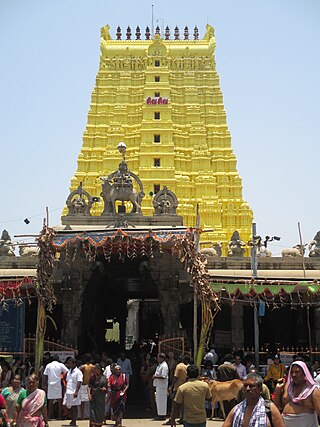
The Ramanathaswamy Temple is a Hindu temple dedicated to the Hindu god Shiva located on Rameswaram island in the state of Tamil Nadu, India. It is one of the twelve Jyotirlinga temples. It is one of the 275 Paadal Petra Sthalams, the sacred sites glorified by the Nayanars, Appar, Sundarar, and Sambandar, with their songs. According to tradition, the lingam of the Ramanathaswamy Temple was established and worshipped by Lord Ram before he crossed the bridge called Rama Setu to the island kingdom of Lanka, identified with Sri Lanka. It is one of the Char Dham pilgrimage sites. The temple was expanded during the 12th century by the Pandya Dynasty, and its principal shrine’s sanctum was renovated by Jeyaveera Cinkaiariyan and his successor Gunaveera Cinkaiariyan, monarchs of the Jaffna kingdom. The temple has the longest corridor among all the Hindu temples of India. It was built by King Muthuramalinga Sethupathy. The temple is considered a pilgrimage site for Shaivites, Vaishnavites, and Smartas.

In Hinduism, the yatra (pilgrimage) to the tirthas has special significance for earning the punya needed to attain the moksha (salvation) by performing the darśana, the parikrama (circumambulation), the yajna, the Dhyana, the puja (worship), the prarthana, the dakshina, the seva, the bhandara, etc. These sacred places are usually located on the banks of sacred waters, such as sacred rivers or their tributaries, the kundas, the ghats, or the stepwells, or the temple tanks.
Swami Vishnu Tirtha (1888–1969), also known as Munilal Swami, was a sanyas, writer, and guru with a prominent place in the Shaktipat tradition of Siddhayoga. He was born on 15 October 1888 in Jhajjar, Haryana, India. He stayed with an uncle while obtaining an undergraduate degree, then married and was employed as a teacher in Bilaspur, Chhattisgarh while he obtained a postgraduate degree and a baccalaureate in law from Aligarh Muslim University. He then practised as a lawyer in the Ghaziabad District of Meerut where his assistant was Late Chaudhary Charan Singh the former Prime Minister of India.
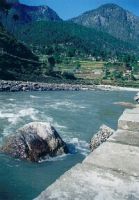
The Tirtha lineage of Siddhayoga is a mystical sect of Shaivite Hinduism. It believes in direct encounters with life-force or kundalini shakti, and understanding of the Shastras. It places importance on the guru-disciple bond, as, according to this tradition, the guru transfers shakti, the divine energy, to the disciple through a transformative process known as Shaktipat. Shakti is said to be automatically infused into a disciple by a guru in a process called Shaktipat.

Haridwar finds mention in numerous scriptures and manuscripts of antiquity, as well as in various historical texts of the recent past. Its significance is also enhanced by the fact that it has been hosting, the famous Kumbh Mela, every 12 years, since time immemorial, wherein thousands of people from all over the country take part, and with whom many stories of its stories have travelled far and wide, and survived in distant lands as a part of the collective oral history of the city.

Sat Vaishnavism, also referred to as Madhva Vaishnavism, the Madhva Sampradaya and the Brahma Sampradaya, is a denomination within the Vaishnavism—Bhagavata tradition of Hinduism. Sadh Vaishnavism was founded by thirteenth century philosopher-saint Madhvacharya, who developed the Tattvavada (dvaita) Vedanta sub-school of Hindu philosophy.
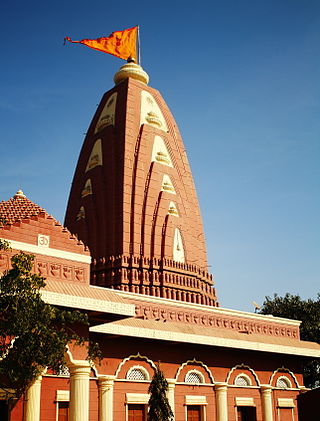
Nageshwar Temple is a Hindu temple dedicated to the Hindu god Shiva located on Dwarka, Gujarat, India. one of the legendary temples mentioned in the Shiva Purana and is one of the twelve Jyotirlingas. Nageshvara jyotirlinga is situated in a forest called Daarukavanam In Gujarat
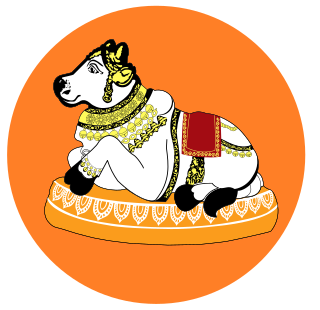
A Jyotirlinga or Jyotirlingam is a devotional representation of the Hindu god Shiva. The word is a Sanskrit compound of jyotis ('radiance') and linga ('sign'). The Śiva Mahāpurāṇam mentions 64 original jyotirlinga shrines in India.
Zenor is a surname. Notable people with the surname include:
References
- ↑ "Zenor, Richard, Rev., 1911-1978". Library of Congress Name Authority File . Washington, DC: Library of Congress. 11 September 2016. Retrieved 3 September 2024.
- 1 2 Lewis, James R. The Encyclopedia of Cults, Sects, and New Religions. Amherst, NY: Prometheus Books, 1998. ISBN 1-57392-222-6